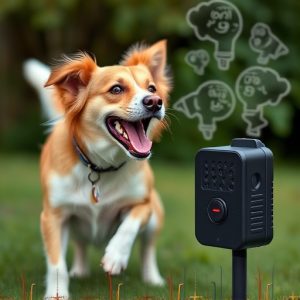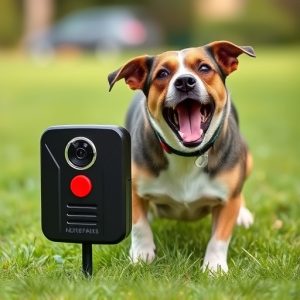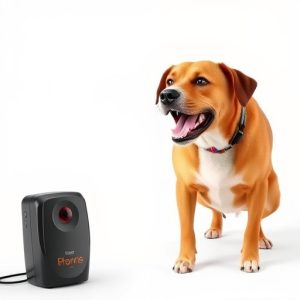Handheld Sonic Dog Deterrents: Assessing Effectiveness for Animal Control
Handheld sonic dog deterrents, emitting high-frequency sounds undetectable to humans, effectively ma…….
Handheld sonic dog deterrents, emitting high-frequency sounds undetectable to humans, effectively manage canine behavior in urban areas by startling dogs and redirecting their attention. Their effectiveness depends on factors like frequency, power, and duration of use, as well as individual dog sensitivity and behavior. Strategic placement, proper maintenance, and adjustments based on local wildlife, expert advice, weather, terrain, and area size are crucial for optimal performance across various settings.
Animals, especially dogs, can sometimes overstep their bounds, causing havoc in our living spaces. Enter handheld sonic dog deterrents—a revolutionary tool offering a humane and effective solution. This article explores the power of these devices, delving into their understanding, effectiveness, and practical implementation. We assess how these sonic deterrents work, dispel myths about their efficiency, and provide considerations for those looking to maintain peace with their four-legged neighbors, emphasizing the importance of understanding Handheld Sonic Dog Deterrent Effectiveness in animal control.
- Understanding Handheld Sonic Dog Deterrents
- Assessing the Effectiveness of Sonic Dog Deterrents
- Implementation and Considerations for Using Sonic Animal Control Tools
Understanding Handheld Sonic Dog Deterrents
Handheld sonic dog deterrents have gained popularity as a humane and effective way to control canine behavior, particularly in urban areas where traditional methods might be less desirable. These devices emit high-frequency sound waves that are inaudible to humans but can startle and disorient dogs, encouraging them to leave the area. The effectiveness of handheld sonic dog deterrents lies in their ability to target specific behaviors like barking, aggression, or unwanted proximity to people or property.
When used appropriately, these tools can safely and reliably redirect a dog’s attention without causing physical harm or stress. However, it’s crucial to understand that their impact is dependent on various factors, including the device’s frequency range, power output, and the dog’s individual sensitivity. Therefore, choosing a handheld sonic dog deterrent designed for specific breed sizes and behavior issues is essential for optimal effectiveness.
Assessing the Effectiveness of Sonic Dog Deterrents
Sonic dog deterrents, or handheld devices emitting high-frequency sound waves, have gained popularity as a humane alternative to traditional shock collars. Assessing their effectiveness is crucial in understanding their viability as an animal control tool. Studies show that these devices can be highly successful in deterring dogs from unwanted behaviors like barking or approaching specific areas. The handheld nature allows for easy deployment and control, making them suitable for various environments.
However, the effectiveness of a handheld sonic dog deterrent depends on several factors. These include the device’s sound frequency range, volume, and duration of use. Additionally, individual dog behavior and sensitivity to sound play significant roles. While many dogs find the sounds unpleasant, others may not react as expected. As such, it’s important for users to understand their dogs’ behaviors and adjust the settings accordingly for optimal results.
Implementation and Considerations for Using Sonic Animal Control Tools
The implementation of handheld sonic animal control tools involves strategically placing the devices in areas where unwanted wildlife presence is a concern. These portable devices emit high-frequency sound waves that are designed to deter animals, primarily dogs and cats, from entering specific spaces. The effectiveness of a handheld sonic dog deterrent lies in its ability to create an uncomfortable auditory experience for the animals without causing harm. It’s crucial to select a device with adjustable frequency settings to cater to different animal species and behaviors.
When considering the use of these tools, it’s essential to assess the local wildlife ecosystem and consult with professionals or experts who can provide insights into the potential impact on non-target species. Additionally, factors like weather conditions, terrain, and the size of the area to be protected should guide the choice of device and its placement strategy. Proper maintenance and regular testing ensure optimal performance, making these sonic deterrents a feasible solution for humane animal control in residential, commercial, and agricultural settings.
Handheld sonic dog deterrents have shown promise as effective tools for managing canine behavior, offering a non-lethal alternative to traditional animal control methods. By understanding their mechanics and assessing their performance in various scenarios, owners can make informed decisions about implementation. Considerations such as sound intensity, battery life, and environmental impact are crucial to ensure these devices work optimally while minimizing potential harm to pets and wildlife. With proper use, handheld sonic dog deterrents can foster a harmonious coexistence between dogs and their communities, enhancing quality of life for all.


